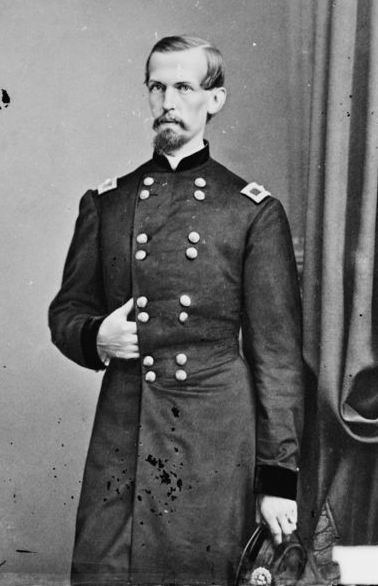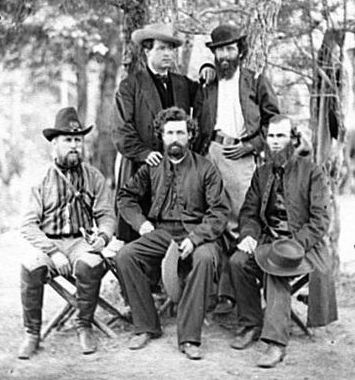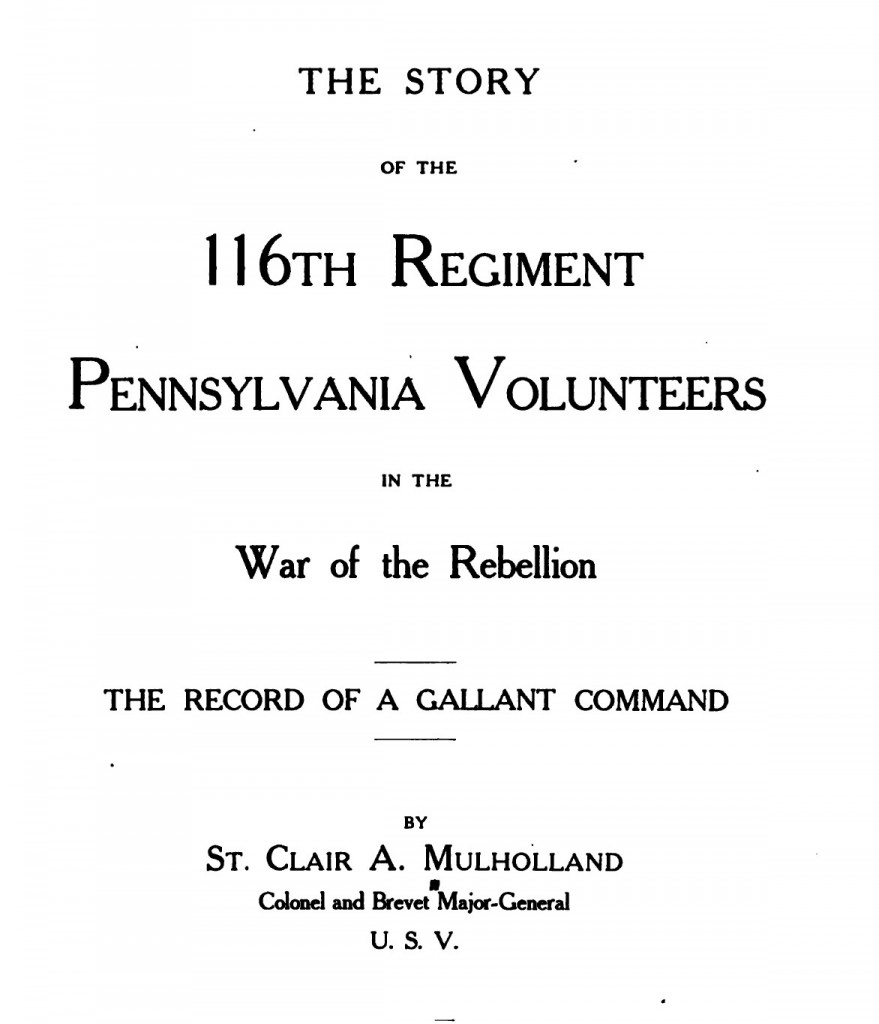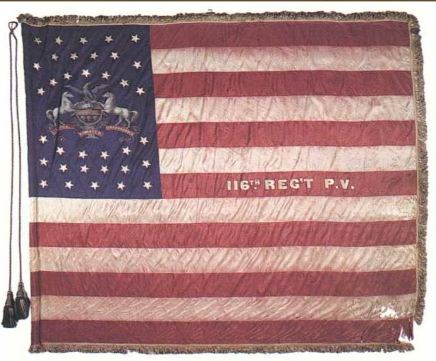Pennsylvanians in the Irish Brigade
Posted By Norman Gasbarro on March 17, 2011
A brigade of Irish troops was originally formed in September of 1861 upon authorization of the Secretary of War. At first it consisted of three New York regiments – the 63rd New York Infantry, the 69th New York Infantry, and the 88th New York Infantry. To give the brigade some additional strength, the 29th Massachusetts Infantry of mostly non-Irish, was assigned to it. After the Battle of Antietam, the 29th Massachusetts Infantry was replaced with the 28th Massachusetts Infantry, which was made up predominantly of Irish immigrants. Afterward, Philadelphia Irish immigrants were recruited to form another regiment,the 116th Pennsylvania Infantry, and that was added to the brigade, bringing it to a full strength of five regiments. See prior post on the organization of the Union army.

Col. Michael Corcoran (1827-1863). He refused to parade his Irish-American troops for the Prince of Wales.
The core of the New York regiments that formed this brigade consisted of the 69th New York Militia and the 63rd New York Volunteers, also known as the “Third Irish.” The 69th had gained notoriety before the war when its leader, Col. Michael Corcoran, refused to lead a dress parade for the Prince of Wales who was visiting New York City. For the refusal, he was put under court martial, but with the advent of the Civil War, he was needed. Charges were dropped and the 69th New York Militia was sent to Virginia. Since many of the immigrants in the early “Irish Brigade” were experienced Irish revolutionaries, the activation of this unit was seen as a warning to Britain to refrain from supporting the Confederacy or there would be repercussions in Ireland. It also helped get solid Irish support for the cause of the Union – which at the time was not the emancipation of slaves. Irish immigrants were concerned about a flood of freed slaves headed north to take jobs that they had to fight to get and many considered joining the Confederacy to help preserve the institution of slavery. In balancing the options, it seemed better to choose the Union cause where the immigrants could prove their worth on the battlefield in a separate “Irish Brigade” which they saw as a way to climb the economic ladder once the war was over. The Confederacy offered no such option to these Catholic immigrants. The creation of an “Irish Brigade” was therefore a clever, strategic move on the part of the War Department. The “Irish Brigade” was assigned paid Catholic Chaplains, chief of which was Fr. William Corby, a Holy Cross priest and a future president of Notre Dame and for the most part, its leaders were of Irish background. But Col. Michael Corcoran formed another unit, known as the Corcoran Legion, also composed of Irish troops. Unfortunately, in 1863, while riding alone, his horse fell on him and crushed his skull. He died instantly.
The history of 116th Pennsylvania Infantry notes that it was recruited in Philadelphia in July and August of 1862. Before the regiment was of proper strength, its members were sent first to Washington and then to Rockville, Maryland, before being sent back to Washington. But on 6 October 1862 it became part of the “Irish Brigade” which had been assigned to the Second Army Corps, First Division. Unfortunately one its earliest engagements occurred when the regiment came out of winter quarters to lose 43 percent of its members at the Battle of Fredericksburg.
From the official history of the Union Army:
Owing to the sad reduction in its effective strength, the 116th Pennsylvania Infantry was consolidated into a battalion of four companies in January 1863, remaining in the camp at Falmouth until the opening of the Chancellorsville movement, in which it was active, and returning afterward to its old camp. Its work at Chancellorsville received special complimentary mention by Gen. Hancock. The battalion lost heavily at Gettysburg, where it was active on 2 July and 3 July, and joined in the southward movement which followed…. [see previous post on Pennsylvania Regiments at Gettysburg, 116th Pennsylvania Infantry]. Winter quarters were established at Stevensburg and during the winter the regiment was reorganized, three companies from Philadelphia and three from Pittsburgh, being added to the reenlisted men of the battalion, which filled the ranks to the required strength. The “Irish Brigade” was closely engaged at the Wilderness… Spottsylvania and Cold Harbor, its ranks again being greatly reduced in numbers by the almost daily encounters of the enemy. The 116th Pennsylvania Infantry arrived in front of Petersburg on 15 June, charged the works the next day and joined in the action at Reams’ Station a few days later. Upon the reorganization of the Second Corps, it was attached to the 4th Brigade, 1st Division, with which it shared in the engagements at Deep Bottom and the raid on the Weldon Railroad in July, the Hatcher’s Run in December, and the skirmish at Dabney’s Mill in February 1865. At the close of the siege the regiment participated in the battle at Five Forks, and after Lee’s surrender, returned to Alexandria, where companies A through D were mustered out on 3 June, and the remainder were mustered out at Washington on 14 July.
The regiment leader was Maj. St. Clair A. Mulholland. In 1903, Mulholland wrote a history of the 116th Pennsylvania Infantry. That book is available as free download from Google Books – click here. Maj. Mulholland was awarded the Congressional Medal of Honor for his actions at Chancellorsville while leading the 116th Pennsylvania Infantry. His citation read: “In command of the picket line held the enemy in check all night to cover the retreat of the Army.”
From the Lykens Valley area and from this Civil War Research Project, five men have been identified as having served in the 116th Pennsylvania Infantry, and therefore in the “Irish Brigade.” Many other Irish immigrants or men of Irish descent from the Lykens Valley area fought in other Pennsylvania regiments, but the purpose of this post is to identify those who specifically served with the”Irish Brigade.”
Those who served in the 116th Pennsylvania Infantry who have been identified as part of this Civil War Research Project are:
George Goodman — Joseph M. Johnson — Jacob J. Schroeder — Adam Wagner — Ellie Wilson
Only some information has been discovered about each of the five men. Records at the Civil War Research Project indicate that George Goodman was “shot in side” during the war. Jacob J. Schroeder was taken prisoner and held at Salisbury, North Carolina for six months where he claimed to have developed rheumatism and heart disease. Adam Wagner was killed in the battle at Petersburg on 14 June 1864 and in 1890, his widow was living in Porter Township, Schuylkill County. She didn’t know much about his military service because his discharge had been destroyed in a fire. Ellie Wilson‘s widow was living in Tower City, Schuylkill County in 1890.
The regimental flag of the 116th Pennsylvania Infantry is part of the collection at the Pennsylvania State Capitol.
Information for this post was taken from the Civil War Research Project collection. The regimental flag of the 116th Pennsylvania Infantry is from the Pennsylvania Civil War Project of Steve Maczuga. Photographs are from Wikipedia and are in the public domain either because their copyright has expired or they are digital copies of originals that are in the Library of Congress. The photograph of Maj. Mulholland is from the Google Book on the 103rd Pennsylvania Infantry, previously cited. Some of the information on the Irish Brigade” is from Wikipedia articles on the Irish Brigade or on its leaders. The official Union army history is edited from the history of the 116th Pennsylvania Infantry available on Ancestry.com.
Anyone with more information about Pennsylvanians in the “Irish Brigade” is invited to submit it, particularly if such information pertains to the veterans from the Lykens Valley area.
 ;
;






I love to read about Irish history. Keep up the great work.
I have researched the Irish Brigade for 26 years. I read your “Pennsylvanians in the Irish Brigade.”
I would like to correct a couple of statements.
One: “The core of the New York regiments…69th New York State Militia” The 69th NYSM was mustered out on August 3, 1861. The 69th New York Volunteer Infantry was the regiment that went into the Irish Brigade.
Two: “Many considered joining the Confederacy to help preserve the institution of slavery.”
I have never heard anything even remotely like this, I seriously doubt it. Any sympathy for the South among Northerners was wiped out on April 12, 1861, at Fort Sumter. The news raced throughout the North “The Flag has been fired upon!” This is why the Union fought on to victory.
The Irish who lived in the North were loyal to the Union.
Although there were some Irish in it, the 116th Pennsylvania was not an Irish regiment.
There are far more Germans than Irish in it. It did not carry a green flag.
You mention five men who were in the 116th Pennsylvania. George Goodman —– Joseph M. Johnson —– Jacob J. Schroeder —–Adam Wagner —– Ellie Wilson
I found Goodman, Johnson, and Wagner in the unit roster. I don’t see Schroeder or Wilson.
This roster is in the back of the regimental history by Mulholland. I assume it is the same roster by Bates, who did rosters of all of the Pennsylvania regiments. I did not see any of these men in burial lists I maintain of the 116th PA. I have used many tactics to track these men down, I will see what I can do for Dauphin Co.
George Goodman Enlisted, no date, to serve three years, and mustered in as private, Company G, on April 18, 1864. Mustered out with company on July 14, 1865. Roster page 447.
Joseph M. Johnson Supposed identical with Joseph W. Johnston Enlisted, no date, to serve three years, and mustered in as private, Company E, on June 14, 1862. Wounded at Fredericksburg, Va., on December 13, 1862.
Transferred to 16th regiment, Veteran Reserve Corps. Roster page 439.
Adam Wagner Enlisted, no date, to serve three years, and mustered in as corporal, Company F, on February 19, 1864. Killed in action at Petersburg, Va., on June 14, 1864 – Vet. Roster page 442.
Vet – veteran, he had served in a unit prior to coming to the 116th PA.
Looking up their service records in the National Archives is the next step. There are ways to track men down, I will see what I can do with Schroeder and Wilson.
Sincerely;
Robert McLernon
Springfield, VA
@ Robert,
Hello I found this site while searching the 116th Pennsylvania. You are so very correct on your comment”Although there were some Irish in it, the 116th Pennsylvania was not an Irish regiment.
There are far more Germans than Irish in it. It did not carry a green flag.”
I had several relatives in the 116th and they were all German (migrated to America in the mid 1700s) Thanks for your research and knowledge of the 116th Pennsylvania Volunteer Regiment
N.M. (Nathan) Bretzin, (20 Sep 1841- 16 Sep 1889) was from Washington, Schuylkill County, PA -baptized in the Lutheran Church in Pine Grove, Schuylkill County, PA, 1 Jan 1842. He was German, not Irish, and served in the 116 infantry, Co. G, from 24 Mar 1864 – 14 Jul 1865.
He is buried in the Lyleville Cemetery, Clearfield County, Pennsylvania, with a headstone provided by the government that notes his Civil War service.
Although his last name has been given as Bretzius, and was derived from it, Bretzin is correct.
Mr. Gasbarro, not to argue what you state about many Irish wanting to join the Confederate forces, I do wonder about the source for it. In a college Civil War history class taken some years back, one of the subjects of lecture was that the Irish, themselves, many who arrived in America as indentured servants, were treated terribly, subjected to a great deal of discrimination, and were often treated worse than most slaves, because their value was less than that of most slaves. Why would they have wished to see others continue to be treated in such a poor manner?
Thanks for the information Cappy. Nathan Bretzin was my great-great grandfather. I have been confused by the surname Bretzius, and where that came from. Not sure if it was the same person, but my mother has been to his grave.
I accept your contention that the 69th New York State Militia and the 69th New York Volunteer Infantry were separate units. However, if any of the men from the said militia re-enlisted in the said volunteer infantry, then they could be considered the “core” of the new group. You would know that better than I since you have access to records that I do not have access to.
I also accept your criticism of my statement that “many” Irish considered joining the Confederacy for the reason I stated. Perhaps “many” is too strong a term. “Some” did and ‘some” resisted the draft. The Irish immigrants that were a strong component of the mine labor in the coal regions (Schuylkill County) in particular were among the draft resisters that caused the governor to send troops to the Pottsville area to keep control during the war. I refer to two previous post on this blog: http://civilwar.gratzpa.org/2010/12/opposition-to-the-draft-of-1862/ and http://civilwar.gratzpa.org/2011/05/the-1863-draft-for-upper-dauphin-county/.
It is unquestioned that “many” Irish took up the Union cause and I hope that is what came across in the tone of the blog post.
In the private correspondence between each other, we have agreed to work together to determine the location of the graves of any members of the “Irish Brigade” who are buried in the Lykens Valley area or who had some association with the geographic area of the Gratz Historical Society Civil War Research Project. Readers should know that you are associated with the Sons of Union Veterans National Graves Registration Database, a project that is attempting to locate and register the graves of all who fought for the Union cause!
For the enlightenment of the readers of this blog, the name “Ellie Wilson” was found in the 1890 Veterans Census for Tower City, Schuylkill Co., as having served in the 116th Pennsylvania. No other records have been found for someone with this name in this regiment. There is speculation that the “Ellie” might be the widow of one of the veterans and this was simply not reported on the census. If any readers have any information about who this individual is or how he/she is associated with the 116th Pennsylvania, I hope it can be supplied with a comment to this blog.
As for Jacob Schroeder, we have located him in the records of the 116th Pennsylvania although under a different spelling. His name is found as Schroeder, Schroader, Shrader and Schrader. The choice of using the “c” in the spelling of the surname is inconsistent for the “sh” sound as with many names of German origin.
Finally, we have a disagreement on Joseph M. Johnson. Your records indicate he was killed in the war. My records indicate that he survived the war and lived well into the 20th century in the Millersburg area and the Reading area. When we come to an agreement on the outcome of his “case,” I will do a separate blog post on the “detective work” that was used to come to a proper conclusion. We still haven’t located his grave, but my suspicion is that it is in the Millersburg or Reading area.
The Sons of Union Veterans (SUV) is welcome to “download” or use any of the gravemarker pictures posted on this site with the cemetery information given and add the information to their database. Likewise, any readers of this blog can contact the SUV directly or use their database which is at http://www.suvcwdb.org/home/.
Corrections, additions, and comments to anything posted on this site are always welcome!
Hi. My great great grandfather was Matthew Murray, Sargent in A company of the 116. He was recruited in Philadelphia. He had immigrated to the USA at the age of 13 from Ireland. He lost his arm at the shoulder in the Wheatfield at Gettysburg on July 2. He survived until 1877 and then died as a result of his injuries. He is buried in Philadelphia PA.
He left a wife, son, and daughter (my great grandmother).
My husband’s great great grandfather, George Freeby, was also in the 116th although Co G. He did not join until after Matthew Murray was discharged. George Freeby was a private and received a pension for a wound to his right foot.
I would appreciate any information you might have concerning my family members.
Thank you
This is a message to Dianne Bott. I’m not certain if we have the same ancestor, but my 3rd great grandfather was Matthew Murray, also in the civil war. I don’t know what regiment he was in, but I do know where he hailed from in Ireland and who his wife and daughter were. I’d like to compare notes with you and see if we have a common ancestor. I hope you check here periodically. Please contact me at kimATkimzyn with the dot com on the end.
Best Regards,
Kim
Hello to both you Kim and Dianne. I also have discovered that I am related to Matthew Murray. He is my 3rd great grandfather. His daughter Mary Ann (Murray) Coyle is my 2nd great grandmother. My mom is a Coyle. Matthew’s wife’s name was Anna (Mallen).
Hi Maureen,
It sounds like we are cousins! Mary Ann and Matthew were my 3rd great Grandparents too. My great grandparents were Margaret and Matthew Coyle of South Jersey. Does that ring a bell? I’d like to compare notes with you if you get time to email. I recently found a lot of census and military records that you might not have seen regarding Matthew Murray and Mary Ann and her husband James. Here is my info with the symbols typed in so I don’t get spam KimzynATgmailDOTcom.
Hope to hear from you!
Kim